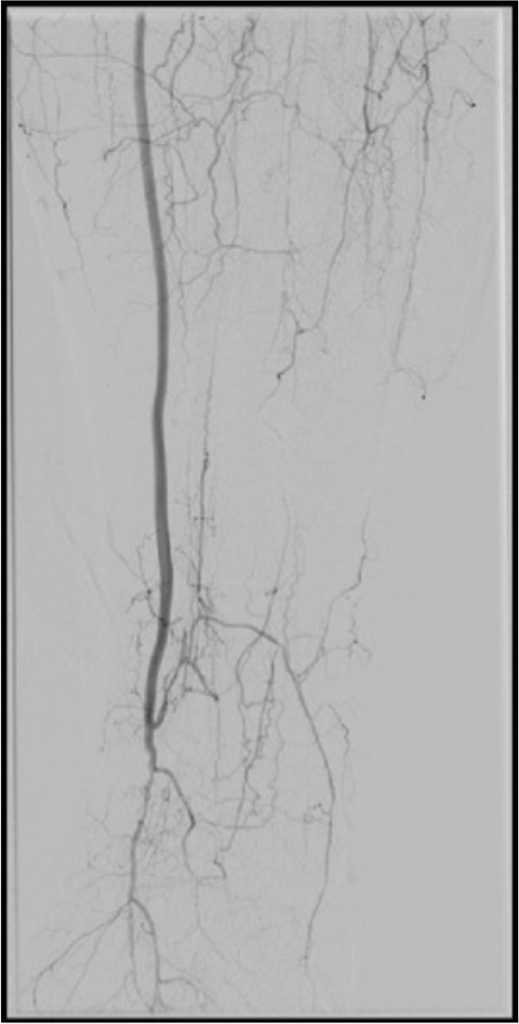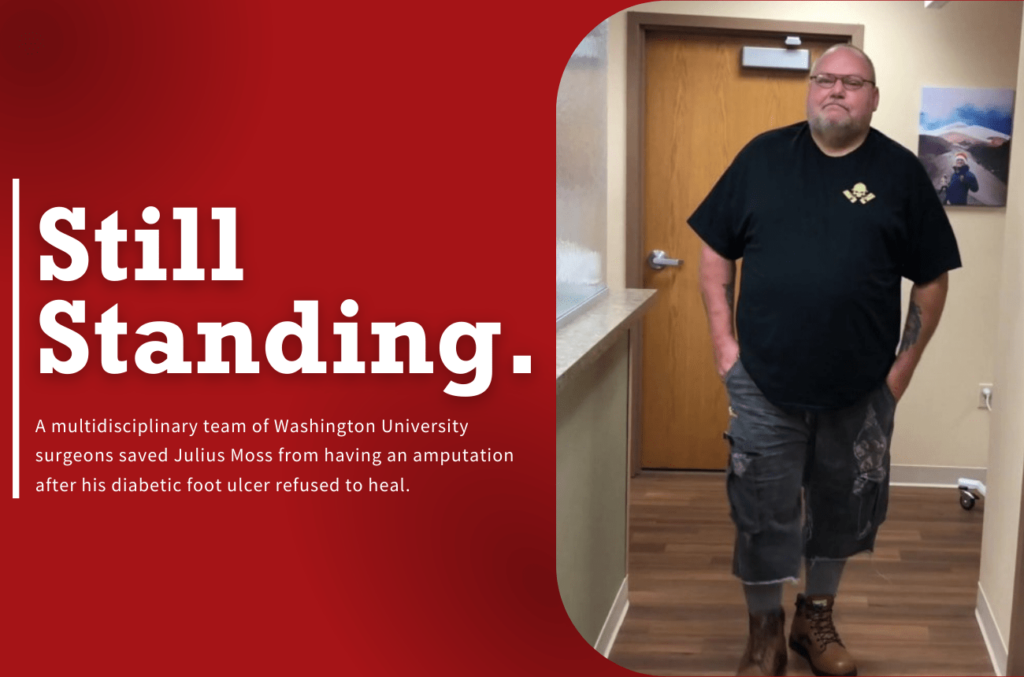Julius Moss has dealt with diabetes and vascular disease for most of his life. Diabetes affects about one in 10 people in the United States, according to the National Institute of Diabetes and Digestive and Kidney Diseases. It is a common, serious disease that occurs when a person’s blood sugar is too high, and can lead to numerous health problems including neuropathy, calluses, ulcers and poor circulation.
“We always called it the family curse,” Julius says.
Julius, who turned 50 last year, has worked some interesting jobs in his life, including as a construction worker and hog farmer. Sometimes, these physically demanding jobs led to injuries made worse by his diabetes and peripheral vascular disease. It was while working on a farm in 2010 that Julius had his foot stepped on by a hog.
“I thought I was going to lose a nail,” Julius recalls. “It looked like the hog had broken one of my toenails.” The injury turned out to be much more serious than he had originally believed. “The toe started to turn black, and I remember seeing streaks of black in the veins running up my leg.”
Julius went to the hospital and had to have a toe amputated. Not long after, another toe became infected and had to be removed.
Having toes amputated caused balance issues for Julius, so he could no longer walk on scaffolding or stilts as he had for many years. He wore a diabetic boot and custom shoe inserts, but still worked as a plasterer in the construction industry. Eventually, Julius developed a diabetic foot ulcer. Despite having bypass surgery years earlier, his foot still was not getting enough blood to heal the ulcer, which grew from the size of a quarter to larger than a silver dollar. Medical interventions did not stop the ulcer from worsening.
For people with diabetes and vascular disease, foot injuries are especially serious. Wounds need healthy blood supply to heal, but these conditions cause poor circulation to the legs and feet. Until the injury and toe amputations, Julius did not realize the severity of his condition.
“I was afraid I was going to lose my foot,” Julius says.
The Next Step
Julius met with members of the Limb Preservation team at Washington University School of Medicine in St. Louis. For some people, the multidisciplinary team of limb preservation surgeons, sometimes called limb salvage surgeons, offer innovative procedures that can save limbs that otherwise might require amputation. The team includes Plastic and Reconstructive, Vascular and Acute and Critical Care Surgeons (ACCS) from the School of Medicine.
“I met Julius at Alton Memorial Hospital, where he came for wound management,” says plastic and reconstructive surgeon John Felder, MD. “It was clear he wasn’t getting enough perfusion to the wound. There are some wounds that get worse, even when they are debrided, because the tissue does not have enough oxygen to heal.”
Felder saw that this problem would take a team to solve, but he was confident that amputation was not the only option.
“Julius,” Felder said, “I think we can save your foot.”
Julius remembers thinking that the procedure Felder described sounded “far-fetched,” but he was willing to trust the surgeon if it meant a chance at standing on his own two feet.
“As long as my foot was going to be saved, I trusted him to go on and do it.”
Felder’s plan was to cover the ulcer on Julius’s foot and send blood to the areas that needed it. Before he could do this, Felder needed answers to some questions: Why wasn’t the bypass on Julius’s leg sending blood to the foot? What was the extent of his vascular disease? He turned to vascular surgeons for answers.
Julius met with vascular surgeon Westley Ohman, MD, for noninvasive tests to better understand the problems restricting his circulation. Ohman then performed an angiogram: a procedure where he inserted a small wire at the hip, which traveled down Julius’s leg, taking pictures of the arteries along the way. A balloon at the end of the wire expanded to help open up the blockage and let blood flow. Then, vascular surgeon Patrick Geraghty, MD, helped expose the bypass Julius had years ago, and placed a stent to keep the vessels open.
These were the first steps in Julius’s surgery. Now it was time for Felder’s reconstructive expertise. Felder had two goals: cover the wound with healthy tissue and provide more blood flow and nourishment to the tissue around the wound so it could heal and remain healthy. He achieved both goals with one procedure called selective arterialization with a flow-through free flap. Felder took tissue from another part of the body—known as a flow-through free flap—and covered the ulcer on Julius’s foot. He then used arteries from the flap to turn the veins of the foot into arteries that could send blood to the toes, through a process called arterialization.

“The unique thing about this procedure is that the hookup to the vein is specifically directed towards the toes,” says Geraghty, who is an authority on arterialization with over 20 years of experience at the School of Medicine. “With arterialization higher up in the leg, we can achieve increased blood flow, but it goes to the entire foot, making the foot appear puffy, and not all blood goes to the desired area. But with a multidisciplinary approach, we can be more selective and direct blood where we want it.”
Back to Normal
Julius, who had multiple toes removed over the years, was close to having another amputation. His doctors in the Limb Preservation program are glad to have helped him avoid further amputations. Ohman and Geraghty note that mortality increases for patients who have below-the-knee amputations, and that many patients who have one amputation will go on to have another in a dangerous cycle.
“Patients are often told they need an amputation, and they have a matter of weeks, days or even hours to process what that means and how they see themselves,” Ohman says. “To see that we can help them avoid that, and to know where they are now, is very rewarding.”
Julius encourages people to seek out the Limb Preservation team before having an amputation.
“Talk to a doctor who speaks to you in plain English about your problem and what they can do to fix it,” he suggests. “Doctors Felder, Ohman and Geraghty will be honest with you. They will tell you what the worst-case scenario might be, but they will work to give you the best outcome.”
After his surgery with the Limb Preservation team, Julius is back to walking and living a normal life. His wife, PJ, was instrumental to the healing process. Julius says she has provided support in every area of his life. This support system is an important part of limb preservation—the healing process can be challenging, and Felder emphasizes the importance of staying off the foot while it heals.
“He can’t walk as fast as me,” PJ, who is a patient care technician at Alton Memorial Hospital, says. “But he is still standing and walking. It forces me to slow down, which is a good thing.”
